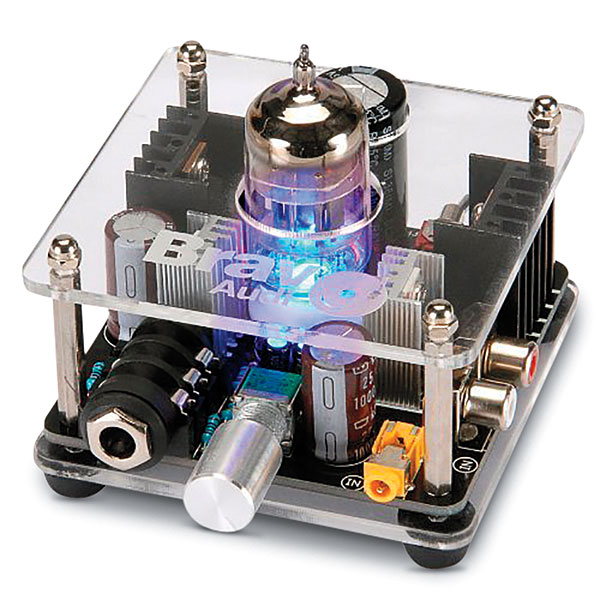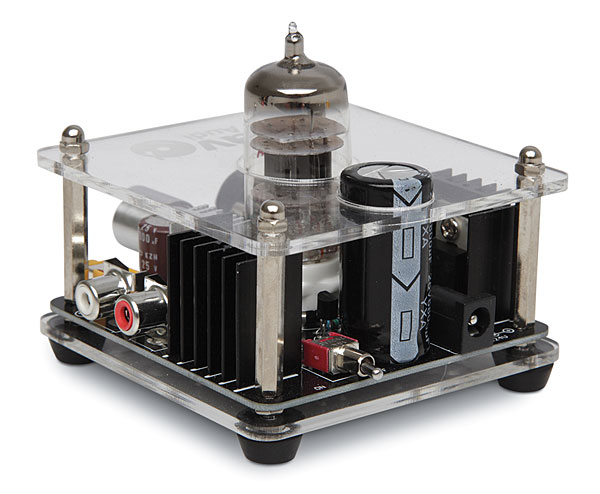As long as I have read S&V you have never mentioned Dared Audio or other Asian brands.. I wonder why?
Tube Amps for Pocket Change Bravo Audio V2
PRICE $68
AT A GLANCE
Plus
Cool looking
1/4-inch jack
Um, did I mention cool
looking?
Minus
No pesky highs or lows
THE VERDICT
If it were a knife, it wouldn’t cut hot margarine.
In the harsh realities of a sober morning, I set about my task, having managed to burn in the three amps overnight. Bravo Audio’s V2 is definitely the coolest looking of the bunch. The single Shuguang 12AU7 tube and big capacitor pierce a clear plastic top, while all the various bits, heatsinks, and connections sit below. The company’s logo is even great, saying Brav Audi in big letters next to an illustration of a record on a turntable.

The Brav Audi feels fairly solidly put together, or about as solid as you can expect from a $68 tube hybrid amp. (Our tech editor Mark Peterson says that, technically, the twin triode sections in the tube act as buffer stages for both channels while the output stages are solid state. Whatever.) It’s the only one of this bunch that has a 1/4-inch headphone output, the others being saddled with, oddly, 1/8-inch outputs only. The V2 even has RCA line-level inputs to go along with its 1/8-inch input. As with the other amps here, an LED embellishes the tube with a blue glow; apparently, each of the three manufacturers decided that a device that actually glows by itself wasn’t enough, and it needed an LED to help.
On the V2, a bright red LED on its circuit board adds to the luminance. [As Peterson also noted, there is an explanation. Line-level vacuum tubes like those employed here have only minimally visible glow, especially if the room isn’t darkened. Power rectifier, power output, and antique tubes are the ones that naturally emit that pleasant orange/blue glow. LED glow-enhancement has apparently been employed since the ’80s.—RS]

My test setup was what I figured a real-world use of these amps would be: analog from my PC’s headphone output, running iTunes (mostly lossless CD rips) into a variety of headphones. Alternately, I used my iPod as the source, running the same files. I’d also had the prescience to buy a FiiO A3 solid-state headphone amp for comparisons with the tube amps; the A3 is $9 cheaper than the V2, and it’s portable.
That said, I started with the $1,099 Oppo PM-1 planar magnetic headphones, because, why not? This is a fantastic set of ’phones, and through the V2, they sounded...boring. None of the planar’s typical succinct attack and openness could be heard. Bass was subdued and sloppy, and low bass was nonexistent.
I swapped in the FiiO A3 immediately. Sure enough, the soundstage opened up, the treble appeared, and the bass got tighter. Maybe the V2 just couldn’t handle the load presented by the PM-1s, or perhaps the designers just voiced it too warm.
Next I tried the Sony MDR7506 ($130), easily my pick for the best over-the-ear headphones under $150. Compared with the FiiO, the V2 seemed to suck some of the air out of the music, made the remaining treble slightly harsher, and bloated the bass like an overstuffed Chipotle burrito.
The V2 sounded its best with the Beyerdynamic DT 990 open-back headphones ($299). It rolled off a bit of the ’phone’s exuberant high end. Grimes’ “Realiti” sounded far more balanced, with a great open spread and decent (though not over-the-top) bass.
Even with my favorite in-ear headphones, the B&W C5 Series 2 ($180), the V2 took away bass definition, made the treble more brittle, and compressed the soundstage. The C5 sounded better connected directly to the PC.
Style over substance, it seems. I didn’t have high hopes for the cheaper remaining contenders.
Specs
Dimensions (WxHxD, Inches): 3.11 x 1.73 x 3.11
Weight (Ounces): N/A
Inputs: Stereo analog (1), 1/8-inch stereo (1)
Outputs: ¼-inch stereo (1)
Output Power: N/A
Output Voltage: N/A
Output Impedance: N/A
Compatible Headphone Impedances: 20 to 600 ohms
Price: $68
Company Info
Bravo Audio
bravoaudio.com
- Log in or register to post comments


Sorry - but I have this product and there is a lot of noise... lots of "electrical" interference. Not great.






























































